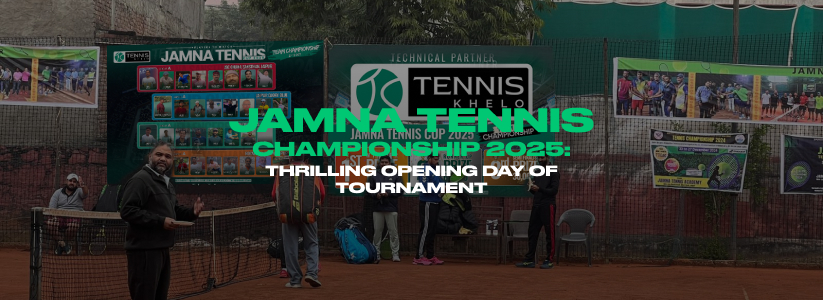Tennis may appear straightforward from the outside—smash the ball, get the point. But when you go deeper, the diversity of match types and formats brings a new level of strategy and thrill to the game. From action-packed one-on-one battles to lively team fights and strategic round-robin teams, tennis tournament formats have something for every type of player and fan.
In this article, we’re dissecting the various formats of tennis matches, discussing how they operate, who they are meant for, and where you can find each format in action. If you’re new to the game or simply in need of a quick refresher, this article by Tenniskhelo, best tennis tournament software in India will make you more knowledgeable about the game.
A Beginner’s Guide to Tennis Tournaments Formats
Singles vs Doubles – What’s the Difference?
One of the questions asked most frequently by beginners is singles vs doubles tennis rules. In singles, it’s an individual confrontation end to end. Each player covers his or her whole side so that it is a real test of endurance, ability, and mind. It is common in: UTR, AITA Championships, ITF Juniors.
Doubles are played two against two. It introduces a new dynamic: positioning, team play, and instant coordination. Doubles also make use of the full court width (doubles alleys included), which alters how points are built and defended. The doubles matches are mostly used in: ATP/WTA Doubles, Davis Cup, local club tournaments.
Also important to know about Mixed doubles feature teams composed of one male and one female player on each side. This format combines the strategies of doubles play with the added element of gender dynamics. It is often seen in major tournaments such as Grand Slams, the Olympics, and various club events.
What is Round Robin in Tennis?
In most tournaments, particularly at club or developmental levels, a round-robin schedule is employed. Curious about what is a round-robin in tennis? It’s a system where every player (or team) plays against all the other members of their group. It guarantees everyone plays several matches, as opposed to knockout systems where one defeat can end your quest.
Round robins are ideal for youth tournaments, early rounds of international tournaments, and experience-based leagues where elimination is secondary to fair play. They are commonly used in tennis leagues, school tournaments, and prestigious events like the ATP/WTA Finals.
Knockout vs Round-Robin Tennis Formats
Let’s discuss tournament formats. Two formats reign supreme: knockout and round-robin. Knockout vs round-robin tennis differ in the manner of progression. Knockouts are sudden-death: lose once and you’re out. They inject intensity and drama—one bad day can send a top player home, which is mostly used in AITA, ITF, and Grand Slams.
Round-robin tournaments, on the other hand, penalize inconsistency and permit players to rebound from setbacks. This is usually applied during the ATP Finals, WTA Finals, and youth tennis leagues to provide a more balanced set of opportunities.
Tennis Scoring and Formats – A Quick Look
From deuce to love and tie-breakers, scoring and formats in tennis can be perplexing initially. In the majority of professional matches, the best-of-three or best-of-five sets are contested by the players. A set is won by taking six games and having a lead of two games or a tiebreaker at 6–6.
In doubles and shorter versions, scoring modifications such as no-ad (sudden death at deuce) or match tiebreaks (first to 10) are standard. These modifications ensure matches remain engaging and tournament calendars are in check.
Other Interesting Formats
Fast4 Tennis: Matches are played in sets of 4 games with no-advantage scoring, making games faster and more dynamic.
Tie-Break Tens: Extremely short matches where only a single tie-break is played to decide the winner.
Timed Matches: Matches are played for a fixed duration instead of sets—commonly used in kids’ events or promotional exhibitions to ensure equal playtime.
Tennis Match Types for Players at All Levels
Tennis is not one-size-fits-all. There is a match type for each age and skill level. Beginners can begin with short sets or mini-match styles. Older advanced juniors tend to transition to full-set play under ITF or AITA rules. Knowing tennis match types for players can assist in fitting your training and competition plan better.
| Match Type |
Event / Factor |
Typical Number of Sets |
Set Format Details |
Players Involved |
Typical Use / miLevel |
| Men’s Singles |
Singles |
Best of 3 or Best of 5 |
Standard 6-game sets, tie-break at 6-6 |
2 male players |
All levels; Best-of-5 mostly in Grand Slams |
| Women’s Singles |
Singles |
Best of 3 |
Standard 6-game sets, tie-break at 6-6 |
2 female players |
All levels; usually Best-of-3 sets |
| Men’s Doubles |
Doubles |
Best of 3 |
Standard 6-game sets, often match tie-break in lieu of 3rd set |
4 male players (2 per team) |
All levels; doubles tournaments |
| Women’s Doubles |
Doubles |
Best of 3 |
Standard 6-game sets, often match tie-break in lieu of 3rd set |
4 female players (2 per team) |
All levels; doubles tournaments |
| Mixed Doubles |
Doubles |
Best of 3 |
Standard 6-game sets, often match tie-break in lieu of 3rd set |
2 male + 2 female players |
Recreational & tournaments |
| Short Sets |
Modified / Beginner |
1 or 2 |
Sets played to 4 games, win by 2 |
Singles or Doubles |
Beginners, juniors, quick matches |
| Tie-Break Sets |
Competitive |
Usually 1 set per set |
Tie-break played at 6-6 games |
Singles or Doubles |
All competitive levels |
| Mini-Matches |
Modified / Beginner |
Usually 1 set |
One short set or timed match |
Singles or Doubles |
Beginners, juniors, practice |
| Pro Sets |
Modified / Recreational |
1 set |
One set played to 8 games, win by 2 |
Singles or Doubles |
Recreational or some tournament formats |
| Best-of-Three Sets |
Standard Competitive |
2 out of 3 |
Standard 6-game sets, tie-break at 6-6 |
Singles or Doubles |
Most amateur & pro matches |
| Best-of-Five Sets |
High-Level Competitive (Men’s singles) |
3 out of 5 |
Standard 6-game sets, tie-break at 6-6 (except some Grand Slams) |
Mainly men’s singles |
Grand Slam events, highest pro level |
How Tennis Tournaments Are Structured
So what do tournaments look like? Club tournaments, AITA circuits, and ITF events each have their way of working. In most, there’s a qualifying draw, a main draw, and occasionally consolation matches. Some employ pools or groups, while others are straight elimination. Understanding how tennis tournaments are organized allows players and coaches to better organize their season.
For instance, ITF and AITA tournament structures generally adhere to knockout or round-robin systems depending on the level, entries, and age group of the event.
A Quick Tennis Guide for Beginners
If you are a beginner to tennis or introducing someone to it, having a clear understanding of beginner tennis game formats is crucial. Begin with shorter formats such as Fast4 (first to 4 games), or one-set contests with no-ad scoring. These make learning exciting, quick, and achievable while still being inclusive of the fundamental rules.
Why Understanding Tennis Formats Matters
Understanding these formats isn’t just for tournament directors or coaches. Whether you’re a casual player or chasing rankings, it affects your approach to warm-ups, strategy, endurance, and even mindset.
For anyone in India looking to learn or compete, check out the TennisKhelo tennis guide—a go-to resource that breaks down formats and rules in easy language.
Final Word: Explore Tennis Formats with TennisKhelo
Wherever you are on your tennis journey, knowing match formats puts you ahead. Whether you are an Indian fan or player, the TennisKhelo match format blog is your go-to guide for all things from tennis rules and types of matches to tournament calendars. Different formats, different battles—discover your winning style.
Explore the best tennis platform in India for guides, rankings, tournament listings, and more. If you’re organizing events, their best tennis tournament software is a game-changer for smooth planning and execution.
Explore exciting upcoming tennis events across India on TennisKhelo.















